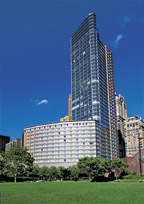There are expected luxuries, and then there are necessities. Advanced security and fire safety systems are recognized to be more important than ever before, especially in public buildings - and especially in public buildings like the new $144.5 million Ritz-Carlton & Residences at Battery Park, located just five blocks south of the World Trade Center site. There may have been a time when these systems were taken for granted by visitors and residents, but that time has passed.

Rife With Challenges
The 40-story, 575,000-sq-ft. combination hotel and luxury residential tower was originally scheduled to open in September 2001. Obviously, the September 11 attacks on the World Trade Center delayed the opening.But there were many other challenges the building's architects, builders, managers, and suppliers had to face. The building's proximity to the harbor presented numerous difficulties. Built on landfill from the old World Trade Center, the site had to be sheeted to keep the water out. The foundation required 80 tie-downs and 650 piles, each with a 200-ton capacity. And, as the basement was actually 12 ft below the water level, a special membrane had to be built around the building's periphery.
There were complications inside the building as well. Because of a three-month delay after September 11, vendors working inside the building had to move quickly - problems had to be addressed quickly with no time for on-the-job training. Classic Designed Systems Inc. was selected as the supplier and installer of the building's fire protection and security systems. The firm opted to use fire alarm systems from Fire Control Instruments (FCI).
An Engineered Solution
New York City fire codes mandate that all residences over 300 ft high have to be equipped with a "strap-key" system, a firefighter's gong-based communication system that needs to be located in the building's elevators. As the facility is part-residence and part-hotel, this system was required, in addition, to have a voice evacuation system. Very few companies offer both of these types of systems and have the engineering capabilities to make these systems work together. "I didn't consider any other fire safety system companies for the job," said Alan Glassman, principal at Classic Designed Systems.Part of the Honeywell Fire Group, FCI custom-engineered the installation. As explained by Dick Aldrich, project engineer with FCI, "Our engineers and technical support team work closely with our distributors to custom-program and configure our products to meet specific market requirements."
The comprehensive FCI system that Classic Designed Systems installed includes a distributed fire alarm/voice evacuation system and an addressable monitor module, as well as analog addressable photo-electronic smoke sensors, analog addressable heat detectors, fixed temperature heat detectors, and other notification appliances and initiating devices.
The heart of the system, FCI's distributed fire alarm/voice evacuation system, provides distinctive signaling, fire fighter telephone communications, and automatic/manual HVAC control functions. With its addressable module, it is able to track down and pinpoint the address of any problematic or initiated detector device.
"It has a built-in redundancy that makes for a much more reliable fire safety system. Every part of the system has its own brain, so it will work even if parts go down as a result of damage to the building. It can accommodate up to five auxiliary command ‘shadow' centers located in remote cabinets. These auxiliary command centers will duplicate the functions of the main central command unit," said Glassman.
All the various smoke and thermal detectors in the building feature programmable sensitivity capabilities that far surpass conventional detectors. This sensitivity is continuously monitored and reported to the control panel.
